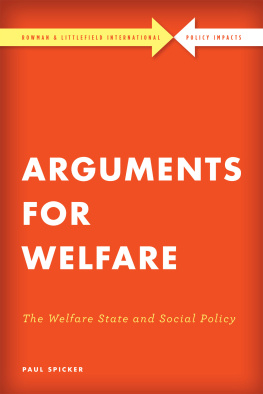Social Welfare
Policy
Dedicated to Dr. W. Bernard Schiele, who was committed to eliminating unjust social policies and their consequences in his day.
Social Welfare
Policy
Regulation and Resistance Among People of Color
Jerome H. Schiele
University of Georgia
Editor
Copyright 2011 by SAGE Publications, Inc.
All rights reserved. No part of this book may be reproduced or utilized in any form or by any means, electronic or mechanical, including photocopying, recording, or by any information storage and retrieval system, without permission in writing from the publisher.
For information:
 | SAGE Publications, Inc.
2455 Teller Road
Thousand Oaks, California 91320
E-mail: | SAGE Publications India Pvt. Ltd.
B 1/I 1 Mohan Cooperative Industrial Area
Mathura Road, New Delhi 110 044
India |
SAGE Publications Ltd.
1 Olivers Yard
55 City Road
London EC1Y 1SP
United Kingdom | SAGE Publications Asia-Pacific Pte. Ltd.
33 Pekin Street #02-01
Far East Square
Singapore 048763 |
Printed in the United States of America.
Library of Congress Cataloging-in-Publication Data
Social welfare policy : regulation and resistance among people of color / editor Jerome H. Schiele.
p. cm.
Includes bibliographical references and index.
ISBN 978-1-4129-7103-4 (pbk.)
1. Social serviceUnited States. 2. United StatesSocial policy. 3. Social service and race relationsUnited States. I. Schiele, Jerome H.
HV40.S61723 2011
362.8400973dc22 2010032178
This book is printed on acid-free paper.
10 11 12 13 14 10 9 8 7 6 5 4 3 2 1
Acquisitions Editor: | Kassie Graves |
Production Editor: | Karen Wiley |
Copy Editor: | Amy Rosenstein |
Typesetter: | C&M Digitals (P) Ltd. |
Proofreader: | Jennifer Gritt |
Indexer: | Holly Day |
Cover Designer: | Candice Harman |
Permissions Editor: | Adele Hutchinson |
Contents
Jerome H. Schiele |
Tricia B. Bent-Goodley |
Iris B. Carlton-LaNey |
King Davis, Allen N. Lewis Jr., Ning Jackie Zhang, and Albert Thompkins |
Jerome H. Schiele and Ellarwee Gadsden |
Hyunkag Cho |
Rita Takahashi |
Anita Gundanna, Marianne R. Yoshioka, and Sujata Ghosh |
Qingwen Xu |
Gregory Acevedo |
Ana L. Len and Debora M. Ortega |
Lisa Magaa |
Catherine K. Medina |
Tessa Evans-Campbell and Christopher Campbell |
Gordon E. Limb and Aaron Baxter |
Hilary N. Weaver |
Jerome H. Schiele |
Acknowledgment
I want to express my deepest gratitude to Ms. Whitney Morreau, M.S.W., who was my research assistant at the University of Georgia and who reviewed several book chapter drafts. Thanks so much, Whitney.
Introduction
Jerome H. Schiele
 RATIONALE FOR A RACISM-CENTERED PERSPECTIVE OF SOCIAL WELFARE POLICY ANALYSIS
RATIONALE FOR A RACISM-CENTERED PERSPECTIVE OF SOCIAL WELFARE POLICY ANALYSIS
This book offers a racism-centered framework to examine how American social welfare policies have regulated the lives of people of color and how people of color have resisted racist, social welfare policies. Although racism has received considerable attention in social work and the broader human services, some suggest that insufficient attention has been devoted to racism in the social welfare policy literature (Lieberman, 1998; Neubeck & Cazanave, 2001; Quadagno, 1994; Ward, 2005).to Neubeck and Cazenave, is not that racism is omitted but that it does not receive primary attention. Neubeck and Cazenave contend that the primary attention on racism is precluded because social welfare policy is interpreted predominantly through three conceptual lenses: class-centered perspectives, gender-centered perspectives, and state-centered perspectives. Although these perspectives acknowledge the presence of racism in the formulation and implementation of social welfare policies, racism is viewed more as an epiphenomenon of social class, gender, or the state-polity structure (Neubeck & Cazenave, 2001).
Even when racism is discussed at length, it still is encapsulated within what are viewed as broader, more overarching and traditional social categories (Ward, 2005). For example, in their book The Dynamics of Social Welfare Policy, Blau with Abramovitz (2004) conceive racism and racial inequality as being subsumed under what they refer to as three longstanding opposing political traditionsconservatism, liberalism, and radicalism (p. 122), and a fourth tradition of feminism. Throughout their text, racism is explained within the context of these broader class-based and gender-based ideologies. Blau with Abramovitz give racism much attention, but racism is not presented as a stand alone ideology equal to the four political traditions they identify. Janssons (2004) The Reluctant Welfare State also marginalizes the coverage of racism. Although Jansson integrates racism in most of his chapters by examining how what he calls outgroups were adversely affected by several social welfare policies throughout American history, his discussion of racism appears to be secondary to what might be referred to as his state-centered perspective. Additionally, Janssons outgroups are not just people of color, but also include women, children, the aged, and gays and lesbians.
The marginalization of racism also can be discerned in Karger and Stoeszs (2005) American Social Welfare Policy. These authors coverage of racism is primarily confined to 2 of their 18 chapters, a chapter on discrimination and one on poverty. Karger and Stoeszs approach to social policy is a pluralistic one in which an examination of the voluntary nonprofit, governmental, and corporate sectors of social welfare services is given prominent attention. However, little focus is aimed at applying this pluralistic approach to the problem of racism. The dominance of the state-centered and social class perspectives also can be gleaned in Popple and Leighningers (2001) The Policy-Based Profession. In their book, Popple and Leighninger acknowledge racism as one of the social values that often influence how social problems are addressed, but they devote scant attention to the application of this value in social policy analysis for the lives of people of color. Finally, Days (2006)














 RATIONALE FOR A RACISM-CENTERED PERSPECTIVE OF SOCIAL WELFARE POLICY ANALYSIS
RATIONALE FOR A RACISM-CENTERED PERSPECTIVE OF SOCIAL WELFARE POLICY ANALYSIS